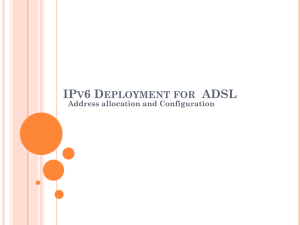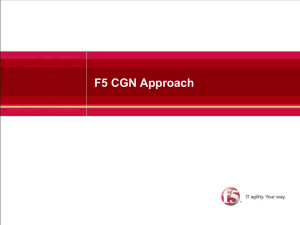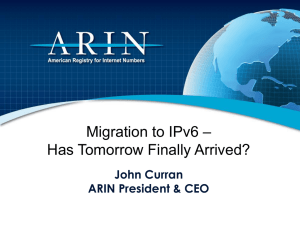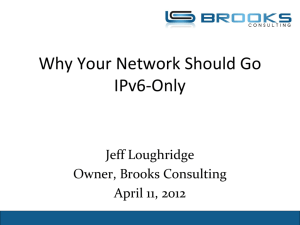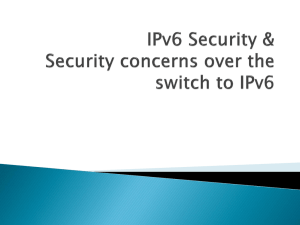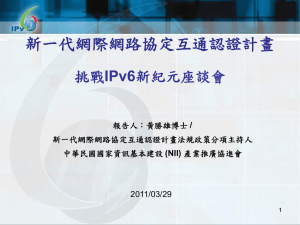IPv6 Migration: A cost estimate Methodology
advertisement
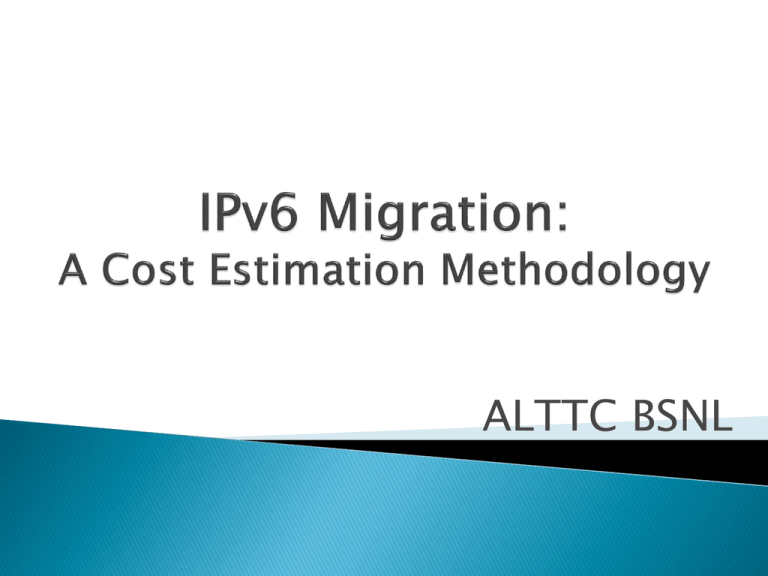
ALTTC BSNL Agenda 1. 2. 3. 4. 5. 6. 7. Introduction Methodology Transition cost and penetration curve Theoretical consideration Migration for Large organization Case study Summary The current generation of IP, version 4 (IPv4), has been in use for almost 30 years and has supported the Internet’s growth over the last decade . Internet experts generally agree that IPv6 based network would be technically superior to IPv4 based network. Increase IPv6 address space and its header structure : Cost estimates are primarily based on likely development and deployment Scenarios. ◦ ◦ ◦ ◦ ◦ will enable to develop new application, Will be more secure, have ease of mobility and renumbering, end to end connectivity Efficient and will provide other benefits H/w, software, services and other miscellaneous expanses. Each organization/or user throughout the internet will incur some cost in transition Primarily in the form of labor and capital expenditures. Expenditure will vary greatly across and within stake holder groups depending on their existing infrastructure and IPv6 related needs. ISPs has to incur largest transition cost. Individual users will incur the minimum cost • Description of stakeholder groups Infrastructure vendors, Application vendors, ISPs and Internet users. ◦ Infrastructure vendors : manufacturers of computer networking hardware (e.g., routers, firewalls, and servers) and systems software (e.g., operating system) that supply the components of computer networks. Major companies in this category include Microsoft, IBM, Juniper, Cisco, and Hewlett Packard. ◦ Application vendors: include suppliers of e- mail, file transfer protocol (FTP) and Web server software, and database software, such as enterprise resource planning (ERP) and product data management (PDM) software. SAP, Oracle, and Peoplesoft are some of the largest companies in this group. ◦ ISPs are companies that provide Internet connectivity to customers, larger companies, some institutional users, and national and regional. e.g., BSNL, Tata telecommunication , AirTel, Vodafone, Idea etc. ◦ Internet users Corporate, institutional, and government organizations, independent users including small businesses and residential households. Affected Business Activities Primary business activities of each stakeholder group that will be affected It is emphasized that all stakeholders will bear costs associated with the transition of their own internal networks from IPv4 to IPv6 Cost Categories ◦ Labor resources will account for the bulk of the transition costs ◦ ◦ Memory and hardware : Some additional physical resources, such as increased memory capacity for routers and other message-forwarding hardware. These expenses are treated as negligible in the cost analysis because it is quite small compared to the labor resources required. ◦ Labor resources needed for the transition are linked to three general business activities within the Internet supply chain—product development, Internet provisioning services, and internal network operations. ◦ other cost: Additionally, several other cost categories, such as network testing and standards and protocol development, span multiple business activities and thus several take holder groups. The penetration curves represent the estimated share of infrastructure products and applications that are IPv6 capable and the share of networks that are IPv6 enabled at a given time. This implies that costs will be distributed over time as stakeholders gradually engage in transition activities. As networking staff are trained and the system is reconfigured. Lower costs associated with testing and monitoring are then experienced after the enabling date. The penetration curves likely deployment/adoption rates for the four major stakeholder groups. The infrastructure (Inf) and applications (App) vendors’ curves represent the path over which vendor groups will offer IPv6-capable products to customers. The penetration of IPv6 is likely to be a gradual process and will probably never reach 100 percent of applications or users. These four curves are the key penetration metrics for the cost analysis because they capture the timing of expenditures. For vendors, R&D expenditures to integrate IPv6 into their products are the primary expenditure category associated with the transition from IPv4 to IPv6. Stockholder Relative cost Hardware software Labor HW vendor Low 10% 10% 80% Software vendor Low /medium 10% 10% 80% Internet user (Large) Medium 10% 20% 70% Internet user (small) Low 30% 40% 30% ISPs High 15% 15% 70% Internet users incur approximately 90 percent of IPv6 transition costs. Vendors and ISPs account for the remaining costs. item H/W, S/W & service providers ISPs Enterprise users H/W cost of replacing interface High (H) Router/chasis/ firewall Medium (M) M M NMS H H OS M H Software upgradation Cost Applications DNS, FTP etc. L ERP & other applications H item H/W, S/W & service providers ISPs Enterprise users labors R&D M L Train Networking /IT employees H H H Designing IPv6 transition strategy M H M/H Implementation transition M M/H M/H L L L Lost employee productivity M M Security intrusions H H M/H M/H Others Ipv6 address block Inter operability issues M The type of internet use or type of service being offered by each organization The transition mechanism that the organization intends to implement( e.g tunneling. Dual-stack, translation, or a combination). The organization-specific infrastructure comprised of servers, routers, firewalls, billing stems and standard and customize network etc. The level of security required during the transition. Timing of transition. Application layer TCP/UDP TCP/UDP IPv6 IPv4 Network interface layer Migration Options APPLICATION Host/Router - IPv4/IPv6 Dual Stack Networks - Tunneling Gateway - IPv4/IPv6 Translation TCP/UDP IPv4 IPv6 DRIVER IPv4 IPv6 Network IPv6 Network IPv6 IPv4 Tunnel Translator IPv6 Network IPv4 Network 22 1 RM = Rs 15 ( approx)





